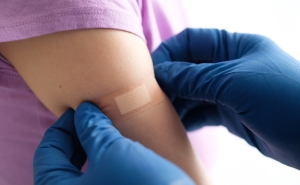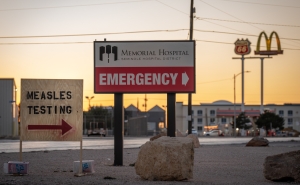
Interview by Stephanie Desmon
What's next for COVID vaccines—and why do we need more? The bottom line: The more vaccines we have that people are willing to take, the better off we're going to be.
In this Q&A, adapted from the April 1 episode of Public Health On Call, vaccine expert Anna Durbin, MD, a professor in International Health, and William Moss, MD, executive director of the International Vaccine Access Center, talk with Stephanie Desmon to give an update on COVID vaccines from different formulations beyond mRNA to the development of vaccines that could be administered through the nose and skin.
There's a Novavax vaccine, a Sanofi-GlaxoSmithKline vaccine, and others in the pipeline. Why do we need more vaccines?
AD: We need more vaccines for a few reasons. One, it's important to remember we're vaccinating the world and we need more vaccines to meet that demand.
But, I think it's also important to note that there are some people who the current vaccines may not be the best for, or who may not feel comfortable taking those vaccines. We still see some hesitancy around mRNA vaccines because it's new technology. I've had patients and people in the community say to me, “The Novavax or Sanofi vaccines look good,” because it's a platform that has been used for other vaccines historically. They're more comfortable with it.
I also think it’s nice that if some vaccines aren't available, for instance, for a second or booster dose, you may be able to have a greater selection or variety if there are production delays and there isn’t enough vaccine of the one that you originally received. We're still waiting for some data to come out, but the more vaccines we have that people are willing to take, the better off we're going to be.
Can you talk about the “second generation” of vaccines being developed?
AD: We've had a lot of different variants over the past two years. The omicron variant is what we would call the most divergent or different. Because of that, we need much higher antibody titers to prevent infection. Having strain-specific variant vaccines or vaccines that most closely resemble the latest variant is an important advance.
We do this every year with the flu vaccine: We match the vaccine to the current circulating strains. I'm not saying that's where we're going with COVID vaccines, but I think it's important. Now that we know omicron is the dominant variant globally, it's important to have a vaccine specifically for [it]. It may be that if you have an omicron-specific vaccine, the antibodies you make or the immune response you mount is more targeted to [omicron], and you may get more durable, better protection in the long run.
Public Health On Call
This article was adapted from the April 1 episode of Public Health On Call Podcast.
We have gone through variants so quickly. Could we miss the boat if we focus on those?
WM: It is possible that a new variant will emerge that can escape immunity from vaccines based on the original version of the virus, as happened with omicron. I think that becomes less likely going forward because there are evolutionary constraints on the virus.
The spike protein of the virus, to which our protective immune responses are directed, has to be able to bind to our cellular receptors in order for the virus to get into the cell and replicate. And so, it can only change so much. If that spike protein mutates wildly, viruses will not be able to enter our cells sufficiently. So there are constraints, but it is possible. That's the wild card—whether there's going to be the emergence of a new variant that can escape not only immunity from earlier variants, but also from omicron.
The Sanofi-GSK, the Novavax, and the Corbavax vaccine from Baylor are all protein-based vaccines. There are advantages in terms of manufacturing, storage, and transport of protein-based vaccines over the mRNA vaccines. [Protein-based vaccines] are technologies that have existed for about 100 years. There are manufacturing capabilities to build them around the world. They don't require the ultra-cold storage that mRNA vaccines do.
There are [also] vaccine delivery platforms that I'm excited to watch. There are a number of companies working on intranasal or mucosal vaccines. Those have the potential to be more effective at protecting against infection. We've seen declining vaccine efficacy against infection and mild disease with our current vaccines and there's been some talk about a pan-Coronavirus vaccine. I don't think that's on the immediate horizon, but that would be ideal—targeting some conserved areas of control of coronaviruses so we don't need to update our vaccine regularly with new variants.
Another technology that I've been watching in the measles field is what we call a microarray patch. You deliver the vaccine on a patch on the skin, almost like putting a Band-aid on and taking it off. I think that's the vaccine delivery platform of the future.
There are countries that use the Chinese vaccine, Sinopharm, and the Russian vaccine, Sputnik, as their primary vaccine. Do we know how effective these vaccines are?
WM: We do have more and more data on the effectiveness of some of these vaccines. Some of the Chinese-manufactured vaccines are inactivated vaccines, and they have not had the level of effectiveness that we've seen with the mRNA or the adenovirus vector vaccines.
When you look at the disease burden in, for example, Sub-Saharan Africa, it still is remarkably low. The question is: Why? Some of this is probably underreporting, but they do not seem to have had their health systems overwhelmed with severe cases as we have in the U.S. Despite the fact that the vaccines used in some of these countries appear to have lower vaccine effectiveness, we have not seen the terrible consequences that one might predict because of that.
When I think about rolling out these COVID-19 vaccines in those countries, I think of the four Ds—doses, delivery, demand, and data—as the necessary system.
First, one needs to have sufficient doses of effective vaccines. But one also needs to be able to deliver those doses once they're in-country, and get them into the arms of people who need them. Many countries have struggled to get the vaccines into adults, but can do it very effectively for children through childhood immunization programs.
We've seen decreased demand for COVID-19 vaccines in countries where we never saw that level of vaccine hesitancy for childhood vaccines for multiple reasons.
Then, countries need to have the data to be able to track who's getting these vaccines and whether they need second or third doses. It's very complex.
Is the effectiveness of the vaccines [these countries] are using a problem and will they need to be re-vaccinated? I would certainly say yes. If we start seeing increased hospitalizations and severe disease among individuals who are previously vaccinated, we need to make changes in our vaccination strategies, and perhaps the vaccines that are being used.
Is there anything the U.S. can do to increase its percentage of vaccinated people?
WM: We've seen a plateauing of unvaccinated people getting first, second, and booster doses. I'm not optimistic that we're going to be able to move the needle much.
I think that it falls into two broad categories: access to and demand for vaccines. The CDC recently issued a report showing disparities in vaccine coverage with rural areas having much lower coverage than urban areas. There are multiple factors that contribute to that. I think we could do a better job at increasing access for some populations in the U.S.
I'm reminded of an effort being undertaken in Sindh province, Pakistan, where they're training 13,000 women to go door to door, building off of their experience with polio and other vaccination campaigns. That's a huge effort, but that's how you improve access—you bring vaccines to people.
That's not going to completely solve the problem in the U.S. because it's not all an access problem. In fact, I think that's probably a smaller proportion of the problem. It's a demand problem. It's hard to say that at this point, as cases, hospitalizations, and deaths are coming down, that we're really going to be able to convince those who are currently unvaccinated and have had access to vaccines to actually get vaccinated.
We are in a different place than we were two years ago, then we were one year ago. What do you see as the vaccine picture going forward?
AD: When I talk to people, I always like to say that we have to manage our expectations. What is the future? The first message is that COVID will not go away; it's not going to disappear. It's going to be with us for the indefinite future, perhaps for years. It may become another seasonal cold virus, but it's not going to go away. We're going to continue to have positive cases. That does not mean we've lost the battle by any stretch of the imagination. What we've seen now is that you can prevent hospitalizations, you can prevent severe disease. We may be living with COVID, but we can have mostly normal lives.
I think it's important to try to prevent spread just as you would with the flu or with another cold virus. Continue to wash your hands. I still wear a mask to the grocery store or crowded places because I haven't had a cold in two years and I don't want to get one. I think it's important to just keep in mind COVID is not going to go away. It's going to be there. You're going to see positive cases, but we are in a much, much better place.
Stephanie Desmon is the co-host of the Public Health On Call podcast. She is the director of public relations and marketing for the Johns Hopkins Center for Communication Programs, the largest center at the Johns Hopkins Bloomberg School of Public Health.





